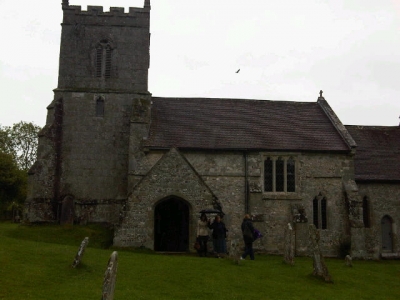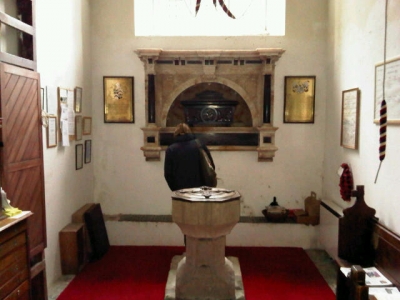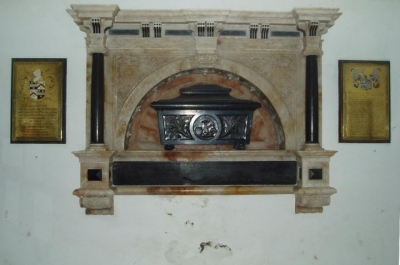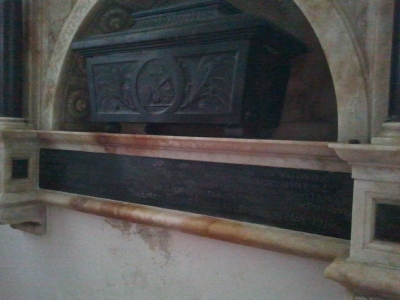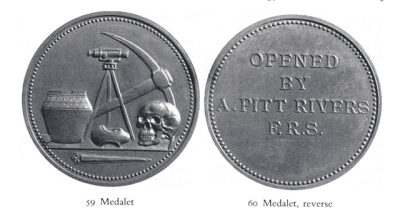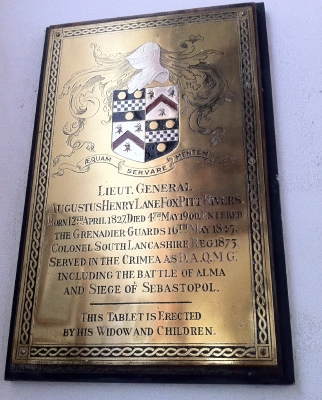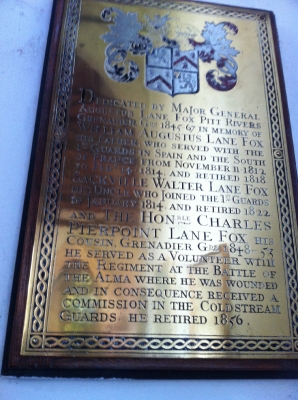To search the RPR site click here
At the church of St Peter ad Vinicula (St Peter in chains) at Tollard Royal in Wiltshire, close to the border of Dorset, is a memorial to Pitt-Rivers. This is placed on the wall at the back of the church, below a window and flanked by two brass plates to other members of the Pitt-Rivers' family, which were put up by Pitt-Rivers himself. There are other memorials to other members of the Pitt-Rivers family elsewhere in the church.
The memorial was put up by his heir and eldest son, Alexander, after his death as the text below makes clear. The sarcophagus includes a design, by John Evans on the front. Its motifs of pick axe, surveying equipment, pot and human skull are the same motifs as on the medallion (or medalet as he termed it) that he had caused to be made, which he used to place at the base of his excavations before they were filled in. These marked his temporary presence and acted as dating evidence. Christopher Evans has suggested that the design (which might almost be called Pitt-Rivers' logo in twenty-first century parlance):
Whilst generally evocative of the compass of the Freemasons’ symbol (see Sweet 2004: 131 concerning antiquaries and Freemasonry), the tripod/triangle of the theodolite in its centre conveys the command of site surveying techniques. The skull to its left references craniological studies, with the array of prehistoric implements denoting the establishment of artefact chronology. In short, it announces the capture of both prehistoric ‘space’ (theodolite survey) and ‘time’ (finds classification).
It must be presumed that the General participated in choosing the medallion’s components as its pick-axe resonates with that which lies just right of him in his oil portrait by Frank Holl (see Bowden 1991: fig. 25). Though obviously ‘archaeological’, the medal’s prominent human skull also evokes a sense of memento mori and, in this capacity, it is surely relevant that Pitt Rivers had its motifs carved upon his sarcophagus in Tollard Royal Church (ibid: fig. 8). This suggests that the medallion’s imagery had qualities of a very personal iconography; a case of personal and disciplinary identity being closely interwoven. [Evans, 2006: 964, 965]
Using the same device on his sarcophagus perhaps marked his temporary presence on the earth, in the same way that the medalet had marked his temporary opening of the earth during excavations.
The memorial also has an inscription below the casket on the slate. It reads:
Augustus Lane Fox Pitt-Rivers FRS FSA DCL of Rushmore Gren Gds [Grenadier Guards] was on the staff of ASDAQMG at the Battle of Alma AAGAT Cork Comm. DG Depot at Guildford First Instr. [Instructor] of Musketry at Hythe and Malta. Devoted the last twenty years of his life to anthropological research. Inspector of Ancient Monuments. Born 12 April 1827 passed away 4 May 1900. Erected in loving memory by his eldest son Alexander Edward Lane Fox Pitt-Rivers. Also of his wife the Hon. Alice Margaret born 30 July 1828 and died 19 May 1910.
The two brass plaques are set on either side of the memorial. The first is surmounted by his coat of arms and motto Aequam Servare Mentem and is inscribed:
Lieut. General Augustus Henry Lane Fox Rivers Born 12th April 1827 Died 4th May 1900 Entered the Grenadier Guards 16th May 1845 Colonel South Lancashire Reg 1875 Served in the Crimea as D.A.Q.M.G. Including the Battle of Alma and Siege of Sebastopol
This tablet was erected by his widow and children.
The second brass plate is also surmounted by a coat of arms and reads:
Dedicated by Major General Augustus Lane Fox Pitt Rivers Grenadier Gds 1845-67 in memory of William Augustus Lane Fox his father who served with the 1st Guards in Spain and the South of France from November 11 1812 to Feb 14 1814, and retired 1818. Sackville Walter Lane Fox his uncle who joined the 1st Guards in January 1814 and retired 1822, and the Hon'ble Charles Pierpoint Lane Fox his cousin Grenadier Gds 1848-1853 He served as a volunteer with the regiment at the Battle of the Alma where he was wounded and in consequence received a commission in the Coldstream Guards. He retired 1856
AP June 2012

